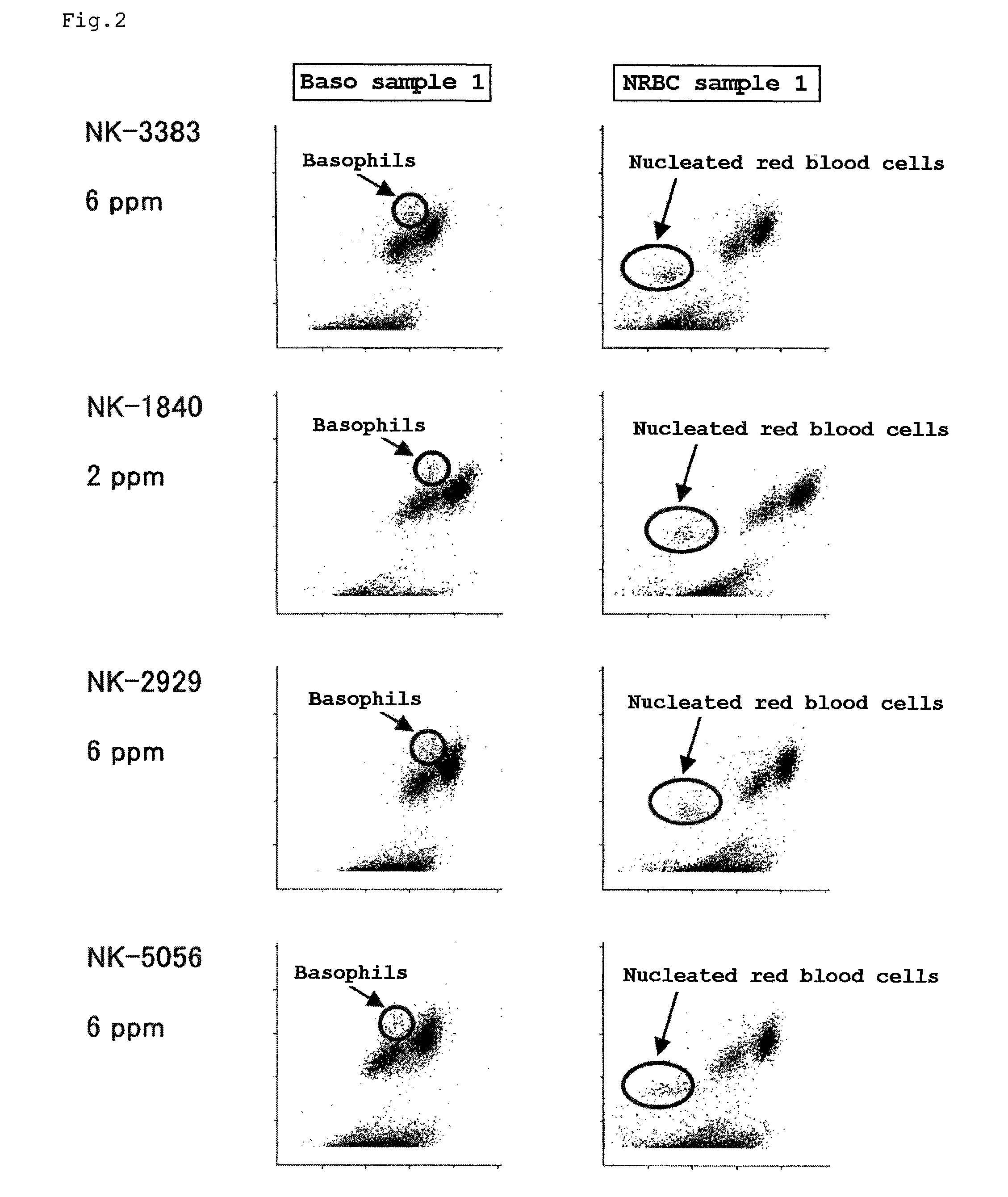Reagent for sample analysis, reagent kit for sample analysis and method for sample analysis
a sample analysis and sample technology, applied in chemical methods analysis, instruments, biochemistry apparatus and processes, etc., can solve problems such as complicated or increased device size, leukocyte measurement, and nucleated red blood cells
- Summary
- Abstract
- Description
- Claims
- Application Information
AI Technical Summary
Benefits of technology
Problems solved by technology
Method used
Image
Examples
example 1
[0112]Into a constant temperature bath at 35° C. was placed 1 mL of an aqueous solution containing 10 mM of salicylic acid (pH: 2.7), 2% of 1-butanol and 3000 ppm of DTAB. To this aqueous solution was added each dye (6 ppm of NK-3383, 2 ppm of NK-1840, 6 ppm of NK-2929, 6 ppm of NK-5056, 2 ppm of NK-9001, 2 ppm of NK-9002, 2 ppm of NK-9003, 2 ppm of NK-4249, and 2 ppm of NK-3606) described in FIG. 2 and FIG. 3 so that each concentration became the aforementioned concentration, respectively, to dissolve it, to obtain each reagent for sample analysis containing each dye.
[0113]One milliliter of the resulting reagent for sample analysis, and 20 μL of a blood sample (Baso sample 1 or 2, or NRBC sample 1 or 2) were sufficiently mixed. The resulting measurement sample was reacted for 20 seconds in a constant temperature bath (35° C.). After the reaction, the measurement sample was taken out from the constant temperature bath, and the measurement sample was guided to a detection part of a f...
example 2
[0123]Into a constant temperature bath at 35° C. was placed 1 mL of an aqueous solution containing 10 mM of salicylic acid (pH: 3.0) and 3000 ppm of decyltrimethylammonium bromide (DTAB). To this mixed solution was added each alcohol (0.05% of 1-heptanol, 2% of 1-pentanol, 2% of 1-butanol, 2% of isobutanol, 1% of 2-butanol, 1% of isoamyl alcohol, 0.5% of 2-phenoxyethanol, 0.5% of 2-phenylethanol) shown in FIG. 4 and FIG. 5 to attain the aforementioned concentration, respectively. Then, to each of the mixed solution was added a fluorescent dye NK-2929 to attain 6 ppm. To 1 mL of each of the resulting reagent for sample analysis was added 20 μL of a blood sample, followed by sufficiently mixing. The resulting measurement sample was reacted for 20 seconds in a constant temperature bath (35° C.). After the reaction, the measurement sample was taken out from the constant temperature bath, and was measured with a flow cytometer as in Example 1.
[0124]For each measurement sample, a scatterg...
PUM
| Property | Measurement | Unit |
|---|---|---|
| pH | aaaaa | aaaaa |
| concentration | aaaaa | aaaaa |
| concentration | aaaaa | aaaaa |
Abstract
Description
Claims
Application Information
 Login to View More
Login to View More - R&D
- Intellectual Property
- Life Sciences
- Materials
- Tech Scout
- Unparalleled Data Quality
- Higher Quality Content
- 60% Fewer Hallucinations
Browse by: Latest US Patents, China's latest patents, Technical Efficacy Thesaurus, Application Domain, Technology Topic, Popular Technical Reports.
© 2025 PatSnap. All rights reserved.Legal|Privacy policy|Modern Slavery Act Transparency Statement|Sitemap|About US| Contact US: help@patsnap.com



